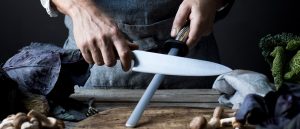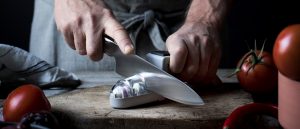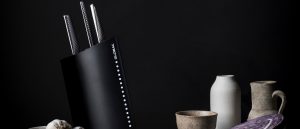Global Knives are factory sharpened at an angle between 10 and 15 degrees. Sharpening at this angle results in a thinner edge, so some words of caution are necessary. Looking after your Global knife is very important, as improper care can severely damage your knife.
A good chef owns a Global knife or two. A great chef also owns a Global sharpening device which sees regular use. Global knives come out of the factory in Japan with a very sharp edge. CROMOVA 18, Globals unique blade material, ensures that this sharpness will be maintained longer than most other knives. However, Global knives need to be sharpened from time to time to maintain their keen edge. As a general rule, the best sharpening tool for an individual is one that he or she is going to use. Each tool is different and may be easy or difficult to use depending on the individual and their level of experience or skill. Global recommends periodically sharpening your knives using either a waterstone or ceramic stone. In between stone sharpenings, it is recommended that you use the Global fine ceramic or diamond rod to keep the edges of your knives aligned.
Note: Global serrated knives do not need to be sharpened

There are various types of waterstones & ceramic stones available and normally a medium grit stone is sufficient to start with. However, if the blade is blunt or damaged, it may be necessary to start with a rough grit. There are several differences between waterstones and ceramic stones. A waterstone must be placed in water and allowed to soak for 10-15 minutes to allow it to absorb sufficient moisture. A ceramic stone also requires water, but only needs to soak in water for 3-5 minutes. A ceramic stone is harder than a waterstone, so it will sharpen your knives more quickly. A ceramic stone will last longer and will not develop valleys or grooves as easily as a waterstone.
Regardless of the size or type of stone you are using, the procedures for sharpening are as follows:
- The stone should be soaked for the required amount of time before use.
- Hold the knife so that the blade meets the stone at a 10-15 degree angle, then push back and forth across the stone in smooth steady strokes maintaining the same angle. Maintaining the same angle is most important and you will know that you are maintaining the same angle from the sound the knife makes against the stone. If you are making the same sound with each stroke back and forth against the stone, you are maintaining the same angle.
- Repeat the stage above on both sides of the blade going from one side to the other until your knife is sharp and there are no burrs on either side.
- During sharpening a certain amount of wet powder will appear, but do not wash or wipe this residue and continue sharpening. Although this powder appears unsightly, it is this residue which sharpens the knives.
- After sharpening, your knives should be washed in hot water and then towel dried.
Note: Achieving the correct angle is sometimes difficult, particular for beginners. Our MinoSharp Sharpening Guide Rails will help to achieve the correct angle when using waterstones and ceramic stones.

The best way to sharpen any knives, not just Global is by whetstone. But for fine-tuning and honing you can use Globals ceramic and diamond steels. Some do prefer to do full sharpening with these ceramic and diamond steels, but for optimum and most consistent results Global do recommend the Minosharp Whetstones.
The ceramic and diamond rods are used in the same way that traditional steels are used to sharpen other knives and, as they are made from the two hardest materials known to man, are suitable for sharpening all good quality knives. The diamond rod is harder than the ceramic rod and will bring back a knife edge quicker. The diamond rod also will not break if it is hit or dropped unlike the ceramic rod. However, the ceramic rod will give a finer edge if used regularly and replacements may be purchased if necessary.
Note:
- DON’T use traditional steels made from other materials as they are likely to damage your Global knives.
- The ceramic steel through use can discolour – this is residue that has built up in the pores of the ceramic. Use warm soapy water and if necessary a scourer to help keep your ceramic steel clean

For some people, learning the skill of intermediate sharpening with a ceramic or diamond rod is difficult. It is essential that you maintain your knives on a regular basis and it will be easier to maintain them for the long term. These are handheld ceramic sharpeners and no experience or skill is required to use them simply fill the reservoir with water and run your knife backwards and forwards a few times. The revolutionary ceramic wheels ensure the blade is sharpened at the correct angle. These water wheel sharpeners are often called the MinoSharp after Mino Tsuchida; Mr Global.
WASHING & CLEANING
Like all good knives, these contain carbon. Carbon softens the steel enough to allow for easy sharpening and for maintaining a razor-sharp edge. Oils, acidic foods and water can react with the carbon and cause black or brown spots in these and any good knives. These are not manufacturing defects and can easily be removed with a cleanser or stainless steel cleaner. The best way to prevent these spots is to thoroughly clean the knives with soap and water, rinse, and then towel dry them after each use. Global knives should not be put in the dishwasher. Doing so could damage the sharp edges if they should come into contact with other objects in the dishwasher. Also, exposure to extreme heat and powerful detergents can be harmful to the cromova 18 high carbon stainless steel. If your knives aren’t cleaned or stored correctly they could start to rust. This rust, just like the spots, can be removed easily with a cleanser or stainless steel cleaner.

Global knives are very sharp and should be carefully stored to avoid accidents and kept out of the reach of small children. Global recommends the use of the Global knife blocks, magnetic wall racks, knife docks, blade guards or knife rolls/cases. A variety of different solutions are offered by Global to help keep your knives safe and in good condition. Shop Global Storage Here.
CAUTION
- Do not cut with a chopping (up and down) motion. This is not the proper way to cut and only dulls your knife. Cut with a slicing (forward and backwards) motion.
- Do not soak before cleaning. In particular, avoid soaking in harsh cleaning solutions and any solution containing bleach.
- Do not use harsh detergents or cleansers containing chlorine bleach.
- Do not use these knives for any purpose other than for what they were intended, i.e. the preparation of food. Under no circumstances should they be used as a screwdriver, crowbar or wirecutter.
- Do not cut on a marble, stone, tile or glass surface.
- Do not attempt to cut through frozen foods or bones. If you should slice into something frozen or solid, remove carefully using a slicing (forward and backwards) motion. DO NOT twist the knife side to side to remove it. Doing so will bend your edge and possibly chip it leaving a chunk of the knife in the solid matter.
THE GLOBAL GUARANTEE
Global knives come with a lifetime guarantee from the manufacturer, against breakage and manufacturing defects.
GLOBAL guarantees any stainless steel product that it sells to be free from defect in material, construction or workmanship under normal use and following the care instructions. This excludes damage caused by misuse or accident. The warranty extends only to the product’s original purchaser
The following problems are NOT COVERED by warranty:
- Black or brown spots. Like all good knives, these contain carbon. Carbon softens the steel enough to allow for easy sharpening and for maintaining a razor-sharp edge. Oils, acidic foods and water can react with the carbon and cause black or brown spots in these and any good knives. These are not manufacturing defects and can easily be removed with a cleanser or stainless steel cleaner. The best way to prevent these spots is to thoroughly clean the knives with soap and water and then towel dry them after each use.
- Bent tips or bent and broken tips. These are usually caused by trying to pry open something with a knife or dropping the knife into the kitchen sink or on the floor, as strong impacts may cause blade chipping or snapping. (If a tip breaks and it is a clean crack, it may be covered.)
- Damaged edges. The edges are razor sharp and razor-thin, and, as with all good knives, if not sharpened regularly, or if used on a hard surface (on dishes or Formica, for example), the edge may develop a roll.
Ceramic Products and Whetstones
Global does not guarantee the other ceramic products or the whetstones that it sells. These items will chip or break if accidentally dropped or hit against a solid object or surface. These items will also wear out after a period of time. Their life expectancy will vary according to the frequency of use. In most instances, we sell replacements for these items.
